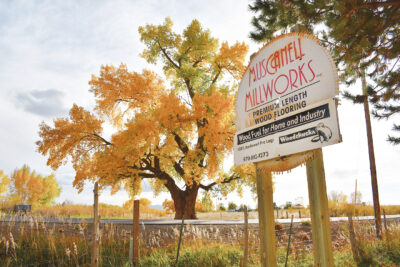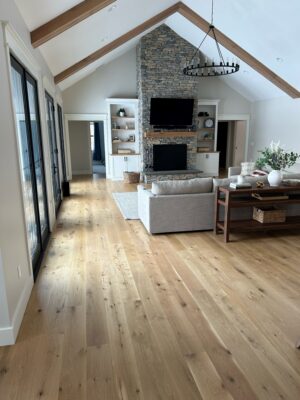BY ALLISON DEFORD
EXECUTIVE DIRECTOR, NORTH AMERICAN FOREST FOUNDATION
COLLIERVILLE, TN
901-860-4131
adeford@northamericanforestfoundation.org
Did you know that more and more, research confirms that being exposed to natural materials can have positive effects on our sense of well-being! And, when used in the classroom, improves learning. #exTREEmelysmart
In a recent article from WoodForGood.com they suggest that based on studies carried out in Norway, Japan, Canada and Austria, wood seems to have positive effects on the emotional state of people.
Environments with wooden structures cause a drop in blood pressure and pulse and have a calming effect.
Consider these facts, revealed in the same Wood For Good Article:
1. Each year we spend 90 percent of our time in buildings or cars.
2. Our surroundings, including buildings still being designed today can create issues like Seasonal Affective Disorder (SAD), depression and lung disease.
3. 90 percent of respondents to a recent survey said they wanted a home that doesn’t compromise their health and wellbeing and a third would pay more for a healthy home.
4. Cognitive abilities increase by 61 percent when in a green building. This increases to 101 percent when additional ventilation rates are introduced.
5. A study conducted in 2010 in an Austrian school compared two ‘timber’ classrooms versus two ‘standard’ classrooms. The benefits for children studying in the timber classrooms were impressive, their heart rates were lowered by up to 8600 heartbeats.
6. The children were noticeably more relaxed and it had a positive effect on their performance too, as well as, leading to a decreased perception of stress.
7. A Japanese study found exposure to wooden panels significantly decreases blood pressure, while exposure to steel panels makes it rise.
8. Workers in offices with wooden interiors conveyed feelings of innovation, energy and comfort. Workers in offices without wood conveyed feelings of their environment being impersonal and uncomfortable.
9. Wood products in a room have also been shown to improve indoor air quality by moderating humidity.
10. The reason wood has such a good effect on human health is because of how it lowers the sympathetic nervous system (SNS) activation. SNS is what causes stress responses, increases blood pressure, heart rate and inhibits functions like digesting, recovery and repair. When surrounded by nature and wood, these symptoms lower.
As you probably guessed, as a foundation focused on harvesting the next generation through education, we find the positive impact wood has on children and learning significantly important.
In an article from WoodProducts.fi it was shown that “the favorable psychological effects of wood have been proven in schools. In classrooms with whole-wood interiors, the morning stress peak, measured as a variation in pulse rate, subsided soon after arriving at school and did not rise again. In a normal control classroom, a mild level of stress in pupils continued throughout the day. Their experiences of stress, such as fatigue and feelings of inefficiency, were less in wooden classrooms than in normal ones.
Joe Mayo AIA, LEED AP, an architect at Mahlum in Seattle, focuses on design for education and wood in mass timber applications.
His findings are that “human minds understand wood texture as non-living, but still associate it with representations of living things. School interiors that feature wood and bring nature indoors provoke positive psychological responses similar to how trees elicit biophilic responses. Wood in classrooms has even been shown to reduce stress and heart rates in students; it is calming, but also engaging without being a distraction.
When wood is used in finishes, environments are enriched both visually and tactilely. Such complex environments have been shown to increase performance on intelligence tests, while other studies have shown that people judge spaces more favorably when wood is present, perceiving wood interiors as warm, inviting and relaxing. A Japanese study further showed wood had influenced physiological and psychological health more positively than other materials.”
But wait, there’s more!
Sustainability, a Secondary Benefit
Wood can also benefit school communities when used as a building’s primary structural material. It can be less expensive to construct and has lower embodied energy and better environmental traits than other standard structural materials.
For example, glue-laminated timber beams can be salvaged from a demolished building, sanded and reused in the new school’s roof structures.
In addition to light wood framing, cross-laminated timber (CLT) has gained popularity over the last several years as an innovative and environmentally friendly solution used in schools across the country.
There’s also no substitute for real wood, as studies show that the positive effects of wood cannot be reproduced with imitation wood. It smells, looks, and feels different. No living properties to elicit the positive effects mentioned above.
So we say feel good and build with wood!
At the North American Forest Foundation, we’re focused on changing hearts and minds about wood, for good.
Through generous donations from companies and individuals, like you, we’re supplying teachers and kids with free resources, education, and support with our signature Truth About Trees Kits in packaged and digital formats.
Helping kids become #exTREEmelysmart will keep our industry and planet healthy and strong for generations.
With your continued support, we can educate ONE MILLION kids by 2030, encourage young people to choose careers in the forest products industry, and strengthen the fiber of businesses, communities and families, like yours.
Let’s grow something beautiful together.
To learn more about sponsorship opportunities, to make a donation, or find out how you can help change hearts and minds about wood, for good, please visit us at www.northamericanforestfoundation.org or drop me a line at adeford@northamericanforestfoundation.org.
Becoming #exTREEmelysmart feels so good!








